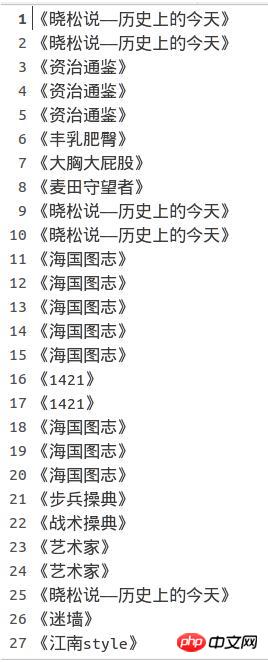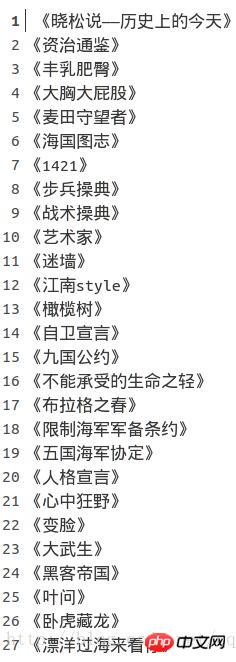python3.4.3下逐行讀入txt文字並去重的方法
- 不言原創
- 2018-05-02 16:17:423050瀏覽
這篇文章主要介紹了關於python3.4.3下逐行讀入txt文本並去重的方法,有著一定的參考價值,現在分享給大家,有需要的朋友可以參考一下
讀寫檔案時應注意的問題包括:
1.字元編碼
2.操作完成即時關閉檔案描述子
3.程式碼相容性
幾種方法:
##!/bin/python3
original_list1=[" "]
original_list2=[" "]
original_list3=[" "]
original_list4=[" "]
newlist1=[" "]
newlist2=[" "]
newlist3=[" "]
newlist4=[" "]
newtxt1=""
newtxt2=""
newtxt3=""
newtxt4=""
#first way to readline
f = open("duplicate_txt.txt","r+") # 返回一个文件对象
line = f.readline() # 调用文件的 readline()方法
while line:
original_list1.append(line)
line = f.readline()
f.close()
#use "set()" remove duplicate str in the list
# in this way,list will sort randomly
newlist1 = list(set(original_list1))
#newlist1 = {}.fromkeys(original_list1).keys() #faster
#rebuild a new txt
newtxt1="".join(newlist1)
f1 = open("noduplicate1.txt","w")
f1.write(newtxt1)
f1.close()
###################################################################
#second way to readline
for line in open("duplicate_txt.txt","r+"):
original_list2.append(line)
newlist2 = list(set(original_list2))
newlist2.sort(key=original_list2.index) #sort
#newlist2 = sorted(set(original_list2),key=l1.index) #other way
newtxt2="".join(newlist2)
f2 = open("noduplicate2.txt","w")
f2.write(newtxt2)
f2.close()
###################################################################
#third way to readline
f3 = open("duplicate_txt.txt","r")
original_list3 = f3.readlines() #读取全部内容 ,并以列表方式返回
for i in original_list3: #遍历去重
if not i in newlist3:
newlist3.append(i)
newtxt3="".join(newlist3)
f4 = open("noduplicate3.txt","w")
f4.write(newtxt3)
f4.close()
###################################################################
#fourth way
f5 = open('duplicate_txt.txt',"r+")
try:
original_list4 = f5.readlines()
[newlist4.append(i) for i in original_list4 if not i in newlist4]
newtxt4="".join(newlist4)
f6 = open("noduplicate4.txt","w")
f6.write(newtxt4)
f6.close()
finally:
f5.close()
結果:
去重前:

#去重前(無序):

去重後(有順序):

總結 這段下程式涉及檔案讀寫操作以及鍊錶List的操作,文章開頭提到的幾個問題,由於並沒有使用中文,所以不關心編碼,但這裡還是要提一提:
f = open("test.txt","w")
f.write(u"你好")
 上面這段程式碼如果在python2中運行會報錯
上面這段程式碼如果在python2中運行會報錯
f = open("test.txt","w")
text=u"你好"
text=text.encode(encoding='utf-8')
f.write(text)關於close()問題:
不關閉會有什麼影響呢?操作完成後,不關閉文件,會對系統資源造成浪費,因為系統可開啟的文件描述符數量是有限的。 Linux是65535。 一般來說close之後就OK了,但是也會存在特殊情況,比如說,在呼叫open()函數時就已經發生錯誤,權限不足,呼叫close()肯定報錯。還有一種是在write()時,如果磁碟空間不足,報錯,close()就沒有機會執行了。正確的做法就是使用 try except 對異常進行捕獲:
f = open("test.txt","w")
try:
text=u"你好"
text=text.encode(encoding='utf-8')
f.write(text)
except: IOError as e:
print("oops,%s"%e.args[0])
finally:
f.close()
更優雅的寫法是用 with…as。
with open("test.txt","w") as f:
text=u"你好"
f.write(text.encode(encoding='utf-8'))
檔案物件實作上下午管理員協議,程式進入with語句時,會把檔案物件賦值給變數f,在程式退出with時會自動的呼叫close()方法。
關於相容性問題: python2和python3的open()函數是不一樣的,後者可以在函數中指定字符編碼格式。 如何解決python2和python3的相容open()問題呢? 使用io模組下的open()函數,python2中的io.open等價與python3的open函數from io import open
with open("test.txt","w",encoding='utf-8') as f:
f.write(u"你好")python下解壓縮zip檔案並刪除檔案的實例_python
##########
以上是python3.4.3下逐行讀入txt文字並去重的方法的詳細內容。更多資訊請關注PHP中文網其他相關文章!
陳述:
本文內容由網友自願投稿,版權歸原作者所有。本站不承擔相應的法律責任。如發現涉嫌抄襲或侵權的內容,請聯絡admin@php.cn

